Meet the team trying to protect Australia’s ‘living dinosaur’, and the ancient rainforest it calls home
Since 1999, Rainforest Rescue has been resolutely working in one of the world’s most extraordinary ecosystems: the Daintree Rainforest in far north Queensland. In a recent feature published by Adventure.com, the organisation’s mission and methods are brought sharply into focus, showing how protecting this 180‑million‑year‑old rainforest isn’t just desirable… It’s essential. In this post we share the full article and reflect on what it means for biodiversity, climate action and the future of this unique landscape.

Southern Cassowary.
Photo: Martin Stringer
With wildlife found nowhere else on the planet and more ancient families of flowering plants than the Amazon jungle, Australia’s Daintree Rainforest is an ecological wonder. But it’s under threat. Here’s how the team at Rainforest Rescue are working to rescue and restore the world’s oldest living tropical rainforest.
I once dated a wildlife cinematographer who spent nine months stowed away in the thickest pockets of the Daintree Rainforest, sweating it out in camouflaged hides, trying to capture footage of the elusive cassowary bird.
And while the romantic relationship didn’t last, my affection and fascination with the cassowary—in particular the southern cassowary, endemic to Australia’s northeastern Wet Tropics—has endured.
In broad strokes, the solitary southern cassowary is like an emu, but bigger. An adult female can weigh up to 180 pounds (85 kilograms), and can stand upwards of six feet tall. The cassowary is basically a dinosaur, and is, in fact, a descendant from the Cretaceous period, when the T-rex still stomped its way through North America.
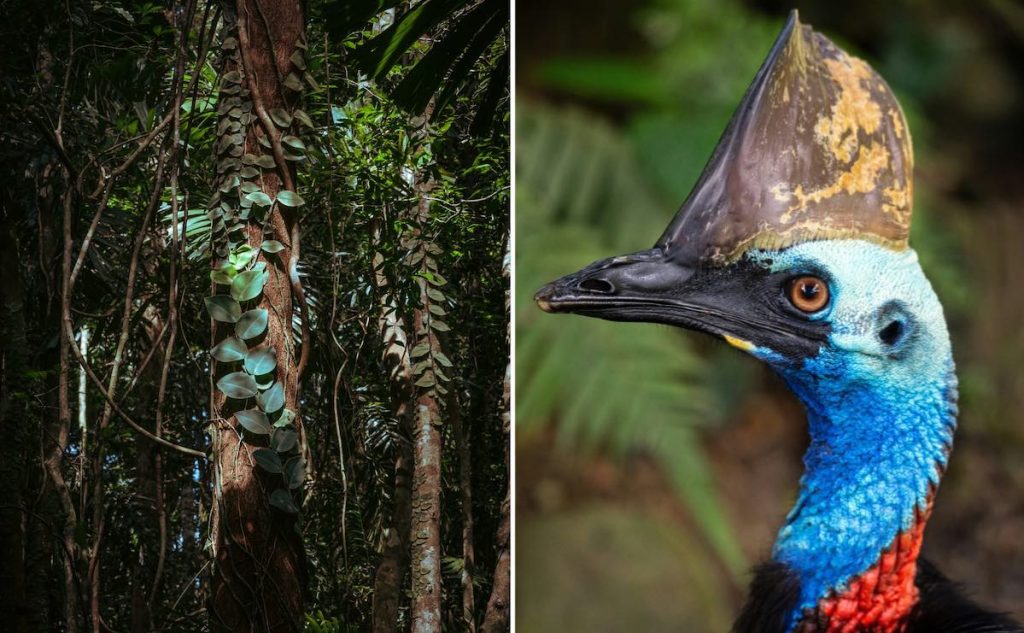
Left: It’s estimated that there are roughly 3,000 different plant species in the Daintree;
Right: Cassowaries are a keystone species in the Daintree, integral for seed dispersal.
Left: Intrepid Travel; Right: David Clode
The evolutionary beauty of this bird is in the detail though: The white casque, grown like a keratinous helmet, is used as a weapon in dominance disputes, protects the cassowary’s head from the forest underbrush, and is even believed to amplify deep sound—their ‘boom’ is the lowest-frequency bird call on record. Then there’s the five-inch dagger-like claws, the porcupine-esque quills, and the legs that can propel the flightless bird up to seven feet in the air on a single jump.
And yet despite being able to claw, jump and swim, the southern cassowary is endangered, at risk of extinction.
“Cassowaries are remarkable birds, and they’re ancient,” Branden Barber, CEO of non-profit Rainforest Rescue tells me. “But the two biggest threats to cassowaries, other than habitat loss, are cars and dogs. And that’s because people insist on putting roads everywhere and insist on letting their dogs run free, even in a national park.”
“When I was in the Amazon, I always felt like I had to watch my back—it feels like a teenager, there’s a lot of chaos. But the Daintree feels like an elder, there’s a lot of tranquility here.”
Branden Barber, Rainforest Rescue CEO
Rainforest Rescue has been working since 1999 to protect and restore the Daintree Rainforest, for all its flora and fauna. But why focus primarily on this parcel of the Wet Tropics? Because the Daintree is over 180 million years old, plays a key role in climate regulation and is exceptionally biodiverse—all of Australia’s unique marsupials, like the koala and the quokka, and almost all its mammals (hello platypus) originated in an ancient iteration of the Daintree.
This rainforest is like a living museum; a priceless recording of evolution. And the southern cassowary is a keystone species within its ecosystem. Without the cassowary dispersing seeds, many plants would struggle to reproduce, threatening the rainforest’s very structure and balance.
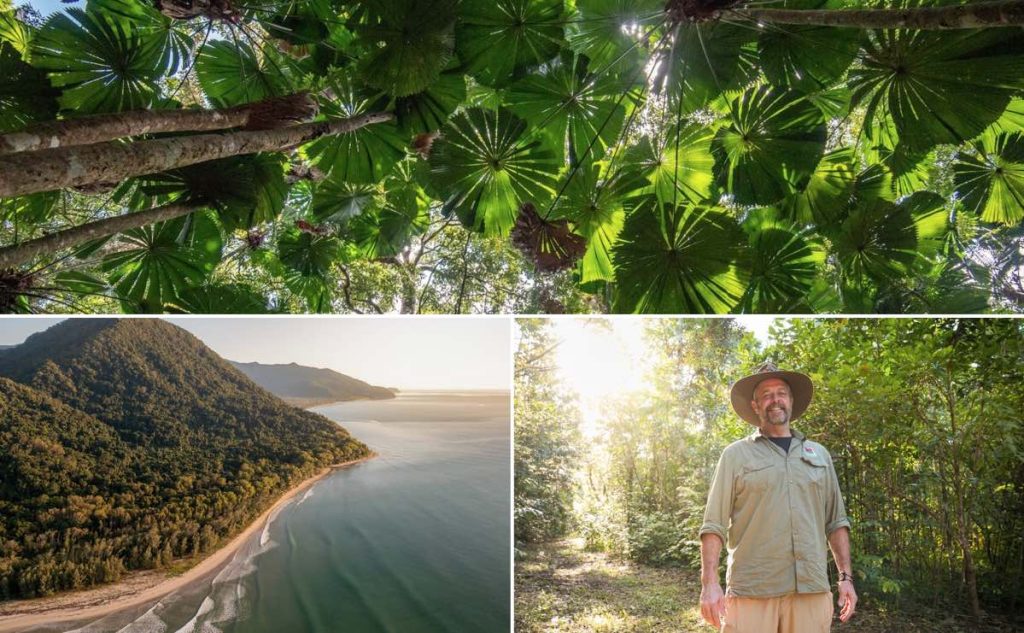
Rainforest Rescue CEO Branden Barber (pictured) describes walking through the
ancient Daintree as tranquil and calming. He is working to protect the biodiversity
that’s unique to the Daintree.
Top: Intrepid Travel; Middle and Bottom: Martin Stringer
“There’s a really interesting difference between walking in the Amazon [jungle] and the Daintree,” says Barber, a lifelong environmentalist, originally from California. “When I was in the Amazon, I always felt like I had to watch my back—it feels like a teenager, there’s a lot of chaos. But the Daintree feels like an elder, there’s a lot of tranquility here.”
When you consider that this is the world’s oldest continuously living tropical rainforest, the elder status makes sense. “It has that sense of embodiment,” says Barber.
“But the short story,” he continues, “is that land has been cleared without really considering nature’s requirements forever. Because capital is more important than nature; because capital is the one wielding the dozer blades. The Daintree isn’t being destroyed like other rainforests, but the threats we face are still real, whether it’s from development or traffic.”
The Daintree Rainforest is part of the UNESCO World Heritage-listed Wet Tropics of Queensland region, but the Daintree National Park and World Heritage areas do not extend to all of the forest, leaving much of the coastal lowland unprotected. As a result, this lowland rainforest area is considered an endangered ecological zone.
Rainforest Rescue is working to protect threatened parts of the Daintree by purchasing and rescuing blocks of intact rainforest, restoring degraded land, and propagating native trees at their nursery facility. So far, they’ve been able to rescue 46 Daintree Rainforest lots, over 160 hectares in total, extending the protected refuges for threatened flora and fauna.
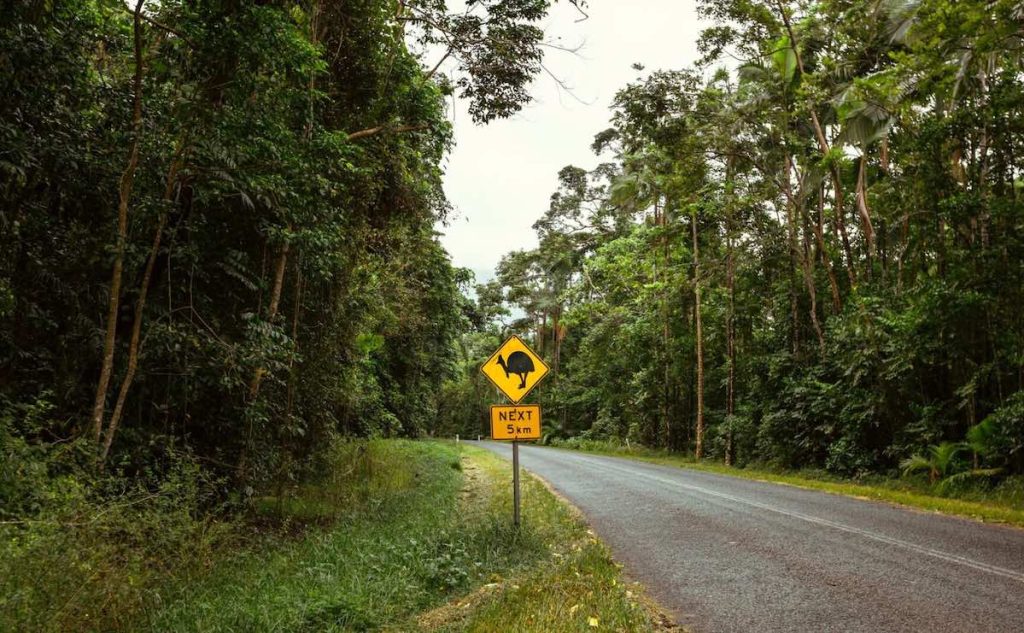
One of the biggest threats to the local cassowary population is the development of
new roads, which impacts their habitat, and being hit by a car.
Photo: Intrepid Travel
There was the protection of Lot 8 Idriess Close, which is now conserving almost 12 hectares of precious habitat for creatures like the Bennet’s tree-kangaroo and, yep, the cassowary. 110 Cape Tribulation Road is 30 hectares of former sugarcane farming land, five hectares of naturally regenerated habitat and 25 hectares that can be restored, which Rainforest Rescue plan on reviving one seedling at a time.
Then there’s Kurranji Bubu, formerly known as Lot 46.
“In Yalanji language, ‘kurranji’ means ‘cassowary’ and ‘bubu’ means ‘land’, so this is cassowary land,” says Barber. “This was the first property we engaged in restoration on… it was 27 hectares, located in the World Heritage Area and used to be a palm tree plantation. We had to remove dozens of trucks of garbage. It was a mess, but through a lot of hard work and years of time, energy and money, we cleaned it up and turned it into a beautiful rainforest again.”
“This is about more than planting trees. It’s about restoring ecosystems, working with Traditional Owners and local land owners… and protecting the incredible biodiversity that’s unique to the Daintree. Quite literally, we are growing the Daintree Rainforest.”
Branden Barber, Rainforest Rescue CEO
Kurranji Bubu is now a recognized nature refuge, an incredible testament to the dedication of the Rainforest Rescue team but also to the resilience of nature.
The restoring part of the Rainforest Rescue model involves ethically collecting seeds, propagating and growing rainforest tree species at their new nursery facility—the largest native nursery in the Daintree. This site is able to produce 150,000 trees per year, which is enough to replant 25 hectares of rainforest annually.

After more than a decade of restoration plantings and growth, Lot 46 was renamed
‘Kurranji Bubu’ (cassowary land) by traditional owners and marked with a smoke
ceremony. This parcel of restored rainforest is now a protected nature refuge.
Photos: Martin Stringer
“This is about more than planting trees,” adds Barber. “It’s about restoring ecosystems, working with Traditional Owners and local land owners… and protecting the incredible biodiversity that’s unique to the Daintree. Quite literally, we are growing the Daintree Rainforest.”
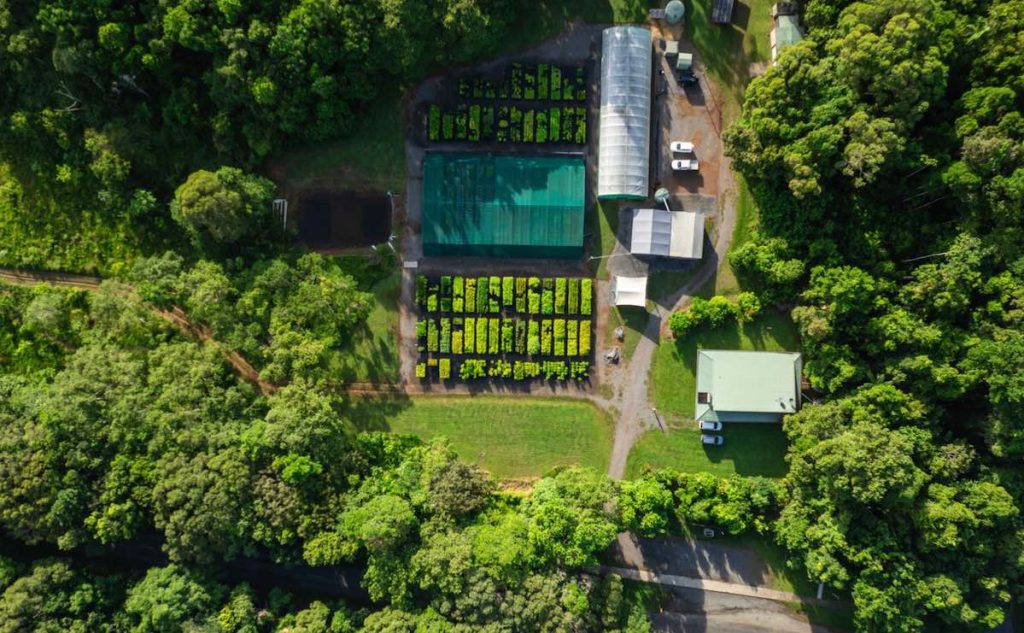
Rainforest Rescue’s Cow Bay native nursery has the capacity to grow 150,000 trees
annually, which is roughly 25 hectares of rainforest.
Photo: Martin Singer
But Barber and the team aren’t stopping there. Rainforest Rescue has partnered with Intrepid Travel, and their non-profit arm The Intrepid Foundation, to build meaningful conservation-meets-travel experiences for tourists visiting the Daintree Ecolodge; they’re advocating for restorative agricultural practices that actually sequester more carbon in the soil; and they’re helping pioneer Australian biodiversity credits—in particular, the Cassowary Credit Scheme which will enable Far North Queensland land managers to generate tradable units of habitat restoration.
It’s an inspiring vision for the region, and when Barber speaks on it his passion is contagious. And his reasoning, foolproof. To protect the Daintree Rainforest is not a maybe, it’s a must.
Now I’ve just got to get up there to see a cassowary in its natural, maybe even restored, habitat for myself.
As the article makes clear, protecting the Daintree is about more than saving trees—it’s about safeguarding living connections: between land and people, flora and fauna, past and future. Rainforest Rescue’s work — rescuing high‑conservation parcels, restoring degraded lowland rainforest, and working hand‑in‑hand with Traditional Owners — is quietly setting a new standard for what rainforest conservation can look like in Australia and beyond. With your support, we move from vision to action. Together, we’re not just preserving the past—we’re cultivating a thriving future for the Daintree Rainforest.

This article, “Meet the team trying to protect Australia’s ‘living dinosaur’, and the ancient rainforest it calls home” was originally published by Adventure.com, powered by Intrepid, was written by Tayla Gentle (June 25 2025).
Want more good Rainforest news in your life?
Subscribe to our eNews | Follow us on Instagram | Like us on Facebook | Subscribe to our YouTube channel
Help Protect Rainforests Forever
Donate to Protect Rainforests Forever | Become a Rainforest Guardian for as little as $2 a month | Partnership Options

